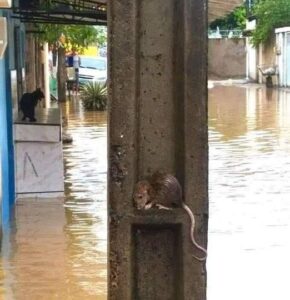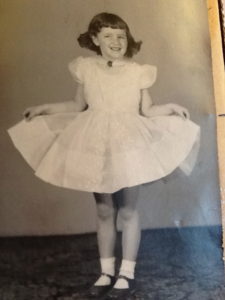A FEW POETIC CREATIVE WRITING IDEAS

USING THIS RAT IN THE FLOOD PHOTO
I found this photo so moving when it popped up on one of my social feeds. I saved the picture and thought about it all day. I thought about it especially hard because October 5th is National Poetry Day and the theme is refuge.
So here we have a little water-soaked rat who cannot find any other place to shelter because of all the rain. What happens? He finds refuge on a tiny shelf in the middle of a concrete telephone pole. Rat is clearly scared. Probably hungry. There is water everywhere. We realise his home is most likely flooded. Where are his family, we wonder? Are they OK?
For the wonderful truth is we humans cannot help but feel empathy for this poor rat and also for the lost cat behind him. After all. In another place or another time, it could very well be us.
This photo also evokes our innate human empathy for any creature – human or animal – who has to flee their home and habitat because of floods, fires or war or any other natural or man-made disasters.
But in addition to feeling sad or worried we want to do something. To express our dismay. To share our understandings and feelings with others. And here is where poetry and creative writing step in.
When you figure out how to say something, you are figuring out at the very same time, what you really FEEL about something. And in discovering and experimenting with the very best words you can conjure up, you get to express your exact thoughts and feelings in those words. Sharing this writing, the world now learns a little bit about who you are and what you feel and think.
And that is really the bottom line of what poetry and creative writing is all about. The sharing of who we are with others.
I have listed four different activities for your classes. They are meant to work for most age groups. Please feel free to make variations in the prompts or put your own twists to it. And create your own. Mine are just a construct, the basic building blocks aimed to make writing feel fun. And important. Because what we think and how we feel and what we say is important. It defines us.
These little exercises have as their aim the empowering of your students. So that they walk home from school thinking: Poetry is fun. It is important. I am important.
Poetry is my friend.
- WRITE A LETTER TO THE RAT
Dear Rat,
When I saw you here I xxxxxxxxxxxxx
Do you worry that xxxxxxxxxxxxxxxxx
Maybe you wonder xxxxxxxx
I hope you xxxxxxxxxxxx
I hope the world xxxxxxxxx
And can you tell cat xxxxxxxxx
Your friend,
xxxxxx
2. WRITE A LITTLE PLAY WITH RAT
RAT AND ME
A VERY SHORT PLAY
ME: How does it feel being trapped like that, Rat?
RAT: xxxxxxxxxxxxxxxxxxxxxxxxxxx
ME: Are you very scared? Do you think it will rain some more?
RAT: Xxxxxxxxxxxxxxx
ME: What happened to your home? And what about your family?
RAT: xxxxxxxxxxxxx
ME: Well. I hope you are OK and that you find some food soon.
RAT: xxxxxxxxxxx
ME: I think you will be OK…just be careful when the rain stops that you stay far away from that cat behind you.
RAT: xxxxxxxxxxxx
ME: Good Luck, Rat
Rat: xxxxxxxxxxxx
3. WRITE A HAIKU ABOUT A RAT
A haiku is a very old type of Japanese poetry where very few words are used to create a little word picture. The traditional rules call for a total of 17 syllables divided into 3 lines.
The first line has 5 syllables. The second 7. And the final line has 5.
The idea is to have the last line be a bit of a surprise after the first two. To strike the reader in some way.
Here is a rat haiku example based on the photograph. You could also create with your class a group of different haiku around the picture…the rain…the cat…the flooded street… home….safety and more.
Rat hides in tall pole
Rain has fallen everywhere
Dreaming dreams of home
4. WRITE A POEM ABOUT FEELING SAFE.
FEELING SAFE
Feeling safe is like xxxxxxxxx
Sometimes I wish could xxxxxxxx
If I were home I would xxxxxxxx
And then I would xxxxxxxxx
But now I am stuck with xxxxxxxx
And wish my hardest I could xxxxxx
That everybody could xxxxxxxxx
I think refuge means xxxxxxxxx




